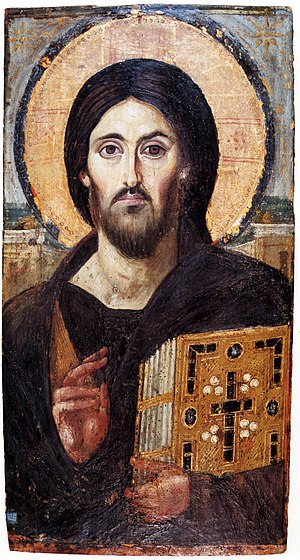Jesus Christ
| [checked revision] | [checked revision] |
No edit summary |
|||
| Line 268: | Line 268: | ||
* [https://newmsgfromgod.blogspot.com/2018/12/the-meaning-of-christmas.html meaning of christmas] | * [https://newmsgfromgod.blogspot.com/2018/12/the-meaning-of-christmas.html meaning of christmas] | ||
* [https://www.giftedchristian.com/ Christian Quotes] | * [https://www.giftedchristian.com/ Christian Quotes] | ||
{{popular | |||
| date = 2024-03-28 | |||
| image = Spas vsederzhitel sinay.jpg | |||
| author = Admin | |||
| mode = <!-- draft, featured, or hidden --> | |||
| keywords = <!-- comma-separated list --> | |||
| description = [[Jewish]] teacher and reformer of religion who is the central figure of Christianity. | |||
}} | |||
[[Category:0s BC births]] | [[Category:0s BC births]] | ||
Revision as of 14:32, 31 March 2024
Jesus of Nazareth (c. 2 BC – c. 3 April AD 33) known to Christians as Jesus Christ, was a Jewish teacher and reformer of religion who is the central figure of Christianity. Christians try to follow the example of Jesus, accept his words to be true, and believe him to be the Jewish messiah who was mentioned in the Hebrew Bible. He is one of the most famous, most recognized, and most influential persons in the world's history.[1][2][3][4]
Most historians agree that Jesus did indeed exist, and was a Jew from a place called Galilee, in a town called Nazareth, in what is now Israel. They also agree that he was thought of as a teacher and a healer, and that he was baptized by John the Baptist. He was crucified in Jerusalem on the orders of Pontius Pilate, and Christians believe that he came back to life - "rose again" - three days later.[5][6][7][8][9]
Jesus taught mostly love and forgiveness for others, as well as being humble about one's moral goodness. He talked many times about the kingdom of God, and told others, "The kingdom of God has come near."[10] He said that one must be mild, like a child, and never boast. He taught that no one deserved God's blessing if they ignored God and other people, but God would forgive them if they repented. Jesus opposed the Jewish priests and other religious leaders because they used religion to boast. The main reason why the Jews didn't like Jesus was because he said that he was the awaited Messiah and that because he fulfilled the law of Moses, it was not needed anymore. Jesus was put on trial and convicted to death by the Jewish leaders,[11] then sent to his execution on a cross by Roman authorities.[12]
There are stories about the life of Jesus by different writers. The best known are the four Christian books called the Gospels. They form the beginning of the New Testament, a part of the Bible. The word "gospel" means "good news". They tell a little about his birth and hidden early life, but mostly about his public life: his teachings, miracles, ministry, death, and resurrection (return from death).
Several Jewish and Roman historians, such as Flavius Josephus, Tacitus,[note 1] Pliny the Younger, and Suetonius include Jesus in their writings. They usually only tell of his execution or problems between the Roman government and his followers; they do not talk about his life.
Manichaeans, Gnostics, Muslims, Bahá'ís, and others have found prominent places for Jesus in their religions.[13][14][15] In Islam, Jesus was a Muslim.[16] Bahá'í teachings consider Jesus to be a "manifestation of God", a Bahá'í concept for prophets.[17] Some Hindus consider Jesus to be an avatar or a sadhu.[18] Some Buddhists, including Tenzin Gyatso, the 14th Dalai Lama, regard Jesus as a bodhisattva who dedicated his life to the welfare of people.[19]
Name
The name Jesus came from the Greek Iesous, from Hebrew Yeshua, meaning "Yahweh is salvation (or deliverance)" in English, and was a popular name of the time. Jesus is often called "Jesus Christ" or "Christ". The word Christ comes from the Greek word christos and means "the one marked on the head with oil" or "the anointed one". In Jesus' country, anointing was done to show that a person was chosen to be a king or a leader. Jesus is also called Messiah, which comes from the Hebrew term Mashiakh, and also means "the anointed one".[20]
Life according to the Gospels
Birth
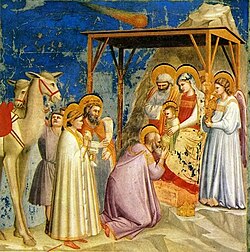
The Gospels of Matthew and Luke say that before the birth of Jesus, both Mary, His mother, and the man that she was promised to, Joseph, knew that Jesus was going to be the Messiah or King that had been promised to the Jewish people, in the ancient Jewish books.[21][22][23]
Luke's Gospel tells most of the story. When Jesus was born, the Roman Empire ruled most of the Middle East. The Government wanted every single family to have their name taken down to be taxed, so everyone had to go back to the place where they came from. Joseph came from the small town of Bethlehem, near Jerusalem, so even though Mary was close to giving birth to her baby, they had to travel, with thousands of other people.[24]
When they got to Bethlehem, every room was full. Jesus was placed in a manger as there was no room for them at the inn. Shepherds who were minding their sheep on the hillside came in to see the baby, and went away singing thanks to God for the newborn king.[25]
In the Gospel of Matthew, it says that wise men from a far country saw a new star in the sky and travelled to find the young Jesus because they knew that the Messiah was going to be born under a star, and that the star was a sign that Jesus was born to be a king. They brought Jesus gifts of gold, frankincense, and myrrh.[26]
Eight days after his birth, Jesus was circumcised and given his name.[27]
Most Christians celebrate the day that Jesus was born as the holiday of Christmas. Although the Gospels do not say what day Jesus was born, the date chosen was of December 25, because there was already a Roman holiday on that day.[28]
Ministry
The arrival of Jesus was known by John the Baptist. He baptized Jesus in the Jordan River. During the baptism, the Spirit of God, like a dove, came down upon Jesus, and the voice of God was heard. According to the Bible, the Spirit led Jesus into the desert where he fasted for 40 days. There, he resisted the Devil's temptations. Then Jesus went into Galilee, settled in Capernaum, and began to preach about the Kingdom of God. He was about 30 years old.
Jesus taught mainly by telling stories. He taught that God alone was the true king, and that people should love God and love each other as the scriptures told them to do. And he taught his followers how to pray. Jesus performed miracles that were signs of God's power, such as giving hungry people food and wine, healing sick people, and making dead people alive again. He also set people free from evil spirits.
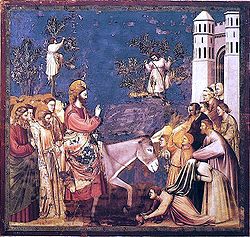
Jesus gathered together twelve men, known as the Twelve Apostles, whom he chose and trained to spread his message. He had many other disciples, including many women, but because of Jewish customs, the women disciples could not travel to distant places on their own as teachers.
The Bible says Jesus became famous. He went to Jerusalem, where many were visiting the city for Passover. When they heard that he was coming, they greeted him as if he was a king. They thought he would free them from the Roman rule, but Jesus rode into Jerusalem on a donkey, as a sign that he came in peace.
Jesus did certain things which upset the Jewish religious leaders. They thought he showed disrespect for customs that the Jews had kept for many centuries. For example, Jews did no work at all on the 7th day of the week, the Sabbath, because it was a holy day. In John's Gospel, chapter 5, there is the story of Jesus healing a crippled man. Jesus saw a man lying on a mattress. He healed the man, and told him to pick up the mattress and go home. Carrying the mattress on the Sabbath was against religious custom, so the religious leaders argued with Jesus about it. They then watched everything he did, and remembered all the things that were against the religious customs.
In Mark's Gospel, chapter 11, it says that when Jesus arrived in Jerusalem, he went to the Jewish Temple. He became angry at what he saw. There were people selling things there, and money lenders who were cheating poor people. Jesus chased away all the people who were selling things. He said the chief priests and scribes had turned the temple into a den of thieves because they were making money from the poor and taking away homes from poor women who had no other way to pay for the temple worship.[29]
Death
The Gospels say that the temple leaders were angry and wanted to kill him. They told the Roman government that Jesus' followers wanted him to become the king of the country and take it over. The gospels say the Roman governor thought that Jesus should be set free, but that the Jewish leaders said, "If you do that, then you are not the friend of Caesar!" (Caesar was the Roman ruler.)
The Governor sentenced him to death because his followers had claimed he was king. The Roman soldiers killed Jesus by crucifixion. He was nailed up to a high cross by his hands and feet. This was a common way for the Romans to kill rebels and criminals.
Jesus' body was buried in a tomb which belonged to one of his followers. On the day after the Sabbath, early in the morning, women went to treat the body with spice and perfumed oil. But the Gospels say that the body of Jesus was gone, and that he was seen alive afterwards. This is called the Resurrection.
Some people, like the disciple Thomas, said, "I'm not going to believe this, until I have seen it with my own eyes!" But the Bible says that more than 500 people, including Thomas, saw Jesus alive again. There are many stories in the Gospels about what Jesus did after he was resurrected. Finally, the Gospel of Luke says that Jesus took his disciples to a hill, where he blessed them and told them to spread his teaching through all the world, and that then clouds came down, and he was lifted up to Heaven.
Most Christians celebrate the time that the Gospels say he died and was raised from the dead as the holiday of Easter.[note 2]
Christian beliefs about Jesus and his teaching
The Christian Church is founded on Jesus. The things that Christians believe about Jesus are based on the four Gospels of the Bible, and on letters or "Epistles" that were written in the 1st century, explaining Jesus' teachings to his followers.
Jesus did not write these letters. They were mainly written by a Jewish man named Paul. At first he tried to stop Christianity from spreading. Then he became a Christian himself and was an important leader. As Christian churches started in different towns and countries, Paul wrote letters to them. A lot of the ideas that Christians believe are written in Paul's letters. There is also lots of instruction for running churches and families.
There are other letters in the New Testament by other writers including Peter, James, and John. These letters all help to build the beliefs that modern Christians have.
See section: Other views about Jesus
Jesus as God
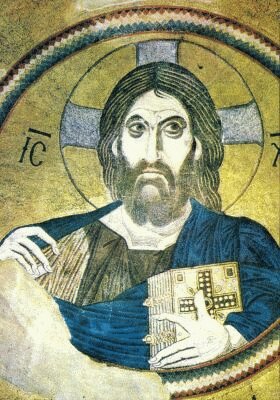
Whether or not Jesus is God has been argued about for a long time. Most Christians, including those from Catholic, Orthodox and Protestant denominations, believe Jesus was both God and man. Jesus is described in different parts of the New Testament as being "the Word of God", "the Son of God", "the Son of Man", and God himself.
These teachings, which are believed by most Christians, are not believed by many other people. The Islamic teaching is that Jesus was a prophet, but he was not part of God or the "Son of God". In Jesus' own time, many Jews became very angry at Jesus for saying that he was the "Son of God" and also because his followers said he was the "Messiah". Most Jews do not believe this.
These Bible verses tell the Christian teaching that Jesus is God:
- " In the beginning was the Word, and the Word was with God, and the Word was God. He was in the beginning with God." John 1:1-2, ESV
- "And the Word became flesh and dwelt among us, and we have seen his glory, glory as of the only Son from the Father, full of grace and truth." John 1:14, ESV
- "I and the Father are one." John 10:30, ESV
- "To them belong the patriarchs, and from their race, according to the flesh, is the Christ, who is God over all, blessed forever. Amen." Romans 9:5, ESV
- "waiting for our blessed hope, the appearing of the glory of our great God and Savior Jesus Christ." Titus 2:13, ESV
- "For in him the whole fullness of deity dwells bodily." Colossians 2:9, ESV
Jesus is also referred to as "the Son of God".
- "And the Word became flesh and dwelt among us, and we have seen his glory, glory as of the only Son from the Father, full of grace and truth." John 1:14, ESV
- "but in these last days he has spoken to us by his Son, whom he appointed the heir of all things, through whom also he created the world. 3 He is the radiance of the glory of God and the exact imprint of his nature, and he upholds the universe by the word of his power. After making purification for sins, he sat down at the right hand of the Majesty on high," Hebrews 1:2-3, ESV
- "And we know that the Son of God has come and has given us understanding, so that we may know him who is true; and we are in him who is true, in his Son Jesus Christ. He is the true God and eternal life." 1 John 5:20, ESV. This letter is thought to be by the same John that wrote John's Gospel.
Many Christians believe that these verses say Jesus is God. All Christians believe that Jesus' death on the cross allows all people to be forgiven by God for their sins (bad things they have done). Most Christians believe that if a person asks God to forgive them He will do so, and they will get to live forever with him in Heaven.[30]
God in human form
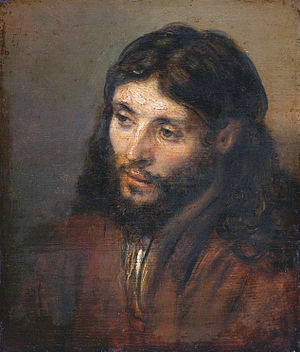
Many Christians believe that, by the teaching of the Bible, Jesus was not only truly God but also truly human and that this was part of God's plan to bring humans closer to understanding him. People who do not have Christian beliefs, have different ideas about Jesus.[31][32]
Verses from the Bible:-
- "And the Word became flesh and dwelt among us." John, 1:14
In Matthew's Gospel, Jesus is often called "the Son of Man". Matthew has borrowed these words from the Old Testament where they are often used to show that humankind is very far from God. In the Bible, God is often praised and thanked for helping ordinary humans, who are called "the sons of man". In Psalm 8, the writer, King David, asks God "what is man that you are mindful of him, and the son of man that you care for him?"[note 3]
In Matthew's Gospel, 24:30 Jesus says "Then will appear in heaven the sign of the Son of Man, and then all the tribes of the earth will mourn, and they will see the Son of Man coming on the clouds of heaven with power and great glory." Like King David, in Psalm 8, Jesus is making a difference between his ordinary human life and his great power as the Son of God.
"The Good Shepherd"
One of the best-loved parts of the Old Testament is a song called Psalm 23. It starts:
- "The LORD is my shepherd; I shall not want. He makes me lie down in green pastures. He leads me beside still waters."[note 4]
In the Gospels, Jesus often spoke about himself as being like a shepherd, caring for sheep. He called himself the "Good Shepherd" who would even give his own life, to protect his sheep. He told the Jewish people, referring to non-Jewish or Gentile believers, that he had "other sheep" that do not belong to this flock. (John, 21:16). In one of his last conversations with his disciple Peter, he told him, "Feed my sheep!", in other words "Take care of my people.".
"The Holy Saviour"
In Judaism, from ancient times, people are seen as sinful or bad. They need to be forgiven by God. They believed that there were two ways to get God's forgiveness, by prayer and by sacrifice. Prayer could be done anywhere, but sacrifices were done at the temple. A person would bring an animal, often a lamb, or if they were poor, a dove. They would put their hands on the animal to lay their sins on it. Then the animal would be killed, as a punishment for the sin. This type of sacrifice continued until the temple in Jerusalem was destroyed in 71 AD. Paying money to the temple was also a sort of sacrifice. When Jesus drove the traders out of the temple, they were the people who sold lambs and doves, and the people who exchanged Roman money into special temple money.
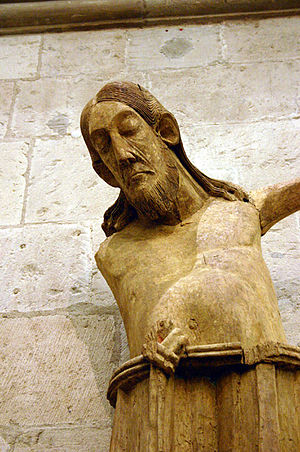
Part of Christian belief is that Jesus Christ did not just come as a human person so that he could teach a better way of life. Christians also believe that Jesus was the ultimate sacrifice for the sin of humankind, that Jesus is the "Saviour": the one who is here to save. Christians believe that, unlike ordinary people, Jesus was completely pure and free from sin, but that when he died on the cross, he took on himself all the sins of every person who would believe in him, like the lamb sacrificed in the temple.[33]
Based on John's Gospel, Christian teaching is that the death and resurrection of Jesus are the sign of his power to forgive the sins of any person who turns to him and truly asks for forgiveness.[30] The Bible says that sinners who are forgiven should try to live a new life and not go back to their sinful behaviour. Christians believe that knowing about God's love helps people to live a new and better life.
These are three verses from the Bible that are important in this Christian belief:-
"For God so loved the world, that he gave his only Son, that whoever believes in him should not perish but have eternal life." John's Gospel, 3:16.
Jesus said to him, “I am the way, and the truth, and the life. No one comes to the Father except through me." John's Gospel, 14:6.
"If we say we have no sins, we are fooling ourselves and not telling the truth. But if we tell our sins humbly to God, then He has promised to listen and to forgive our sins and make us clean from all our badness." from the First Letter of John.
Relics associated with Jesus
- Relics
-
The Vatican Sudarium of Saint Veronica
-
Sudarium of Saint Veronica by Claude Mellan (1649)
-
The Shroud of Turin: modern photo of the face, positive (left), and digitally processed image (right)
-
Full-length image of the Turin Shroud before the [[Conservation-restoration of the Shroud of Turin
-
Tomb of Jesus in Holy Sepulchre church
-
Holy Lance displayed in the Imperial Treasury at the Hofburg Palace in Vienna, Austria
Other views about Jesus
Jesus as a teacher
Some people who are not Christians believe that Jesus lived at the time that the Gospels say, but do not believe that Jesus was the "Son of God" or "Savior". They believe that Jesus was an ordinary, but very good person, a teacher and perhaps a prophet.
Mohandas Gandhi said, "I am a Muslim, and a Hindu, and a Christian, and a Jew," even though he was born a Jain.
Muslim beliefs about Jesus
Muslims believe Jesus was the second-to-last Prophet (messenger of God). They call Him "Isa", the Arabic name for Jesus. They believe that Muhammad was the very last Prophet. They believe that both Jesus and Muhammad were ordinary men, chosen by God to be his servant and teach the word of Islam.
Muslims do not believe that Jesus was God or "the Son of God". Islam is strictly monotheistic: it says that there is only one God. Muslims believe that Jesus cannot be part of God, because there is only one God. If someone other than God is worshiped, it is thought to be polytheism (belief in more than one god). It is also thought to be idolatry: idolizing someone other than God.
Islam teaches that Jesus did not die on the cross, but another man disguised as him went on the cross for Isa (Qur'an 4:157).[34] This is very different from Christianity. Jesus' death is a very important part of the Christian belief about salvation. Muslims always say "peace be upon him" after saying Jesus' name as a sign of respect in short and Arabic a.s.
Muslims also accept some other teachings about Jesus. These teachings say that Jesus will return to the earth in the End Of Days; he will then destroy the false messiah or Anti-christ before the day of judgment. Muslims also accept Jesus' claims to be a healer. They believe in the many miracles he is said to have performed, like raising the dead to life and giving sight to the blind. They believe that all his miracles were granted to him from God.
The Qur'an (like the Bible), mentions the virgin birth of Jesus but then it says other things about Mary (Islamic-Maryam). The Bible says that Joseph helped Mary give birth to Jesus, but in Islam there is no Joseph. Instead, Mary walked the desert alone in labor and found a tree. The angel Gabriel (Jibril) asked if she was hungry, then told her to shake the tree and dates fell for her to eat. Then he asked if she was thirsty and he said look down at your feet and there was water and there she gave birth to Jesus. (Qur'an 19) This is why Muslims fast and how they break their fast. Mary knew she had to go back to her town and when she did, with Jesus in her arms, the people were shouting at her for adultery. Mary wanted to explain herself but the Angel told her not to speak.
Jewish beliefs about Jesus
Even though Jesus was a Jew and his teaching came out of the Jewish religion, most Jewish people do not believe that Jesus was the Messiah that is promised in the Jewish Scriptures.
In the Gospels, it tells that Jesus made the Jewish teachers very angry with his teachings. It says that part of their anger was because he told them they were "hypocrites" which means that they externally made themselves appear to be living a holy life, but internally their hearts were far from God's.
In the Gospels, the other reason that they became angry was that Jesus acted as if he was the Messiah, and said he was the "Son of God". This meant that he was either a terrible liar, that he was mad and just imagined it, or that it was true. But Jesus did not seem to be mad. So that left only two choices. If Jesus was lying, then he was doing something badly against the Jewish religion. It was because of the claims that Jesus was the "Son of God" that some of the Jewish leaders wanted him killed and they handed him to the Roman rulers. The Romans did not care if Jesus said something that was against the Jewish beliefs. But they knew that people had also said that Jesus was "King of the Jews". The Jewish leaders claimed this was against the Roman Government's laws. Although the Roman leaders did not agree, they had him killed to prevent a possible riot.
Although, today and through history, most Jews do not believe what Christians say about Jesus, there are some Jews who do believe that Jesus was the Messiah promised in the Jewish Scriptures. Jews who believe this are called Jewish Christians.
How the Gospels were written
Nearly all modern scholars, both Christian and non-Christian agree that Jesus was a real person. Both Christian and non-Christian scholars base their studies of him on the Gospels. They are believed to have been written between 60-90 AD.[35]
By tradition, the Gospels were written by four men, Matthew, Mark, Luke and John who gave their names to these books. This is the order in which they are arranged in the New Testament of the Bible, but scholars think that it is not the order in which they were written. The Gospel of Mark was probably written before the Gospel of Matthew. The four Gospels all tell the story of the Life of Jesus, but they do it from four different points of view, because they were written by different people and each writer had reasons to tell it in a different way.
Other scholars have said that leaders in the Early Christian Church made changes to the Gospel writings. These changes are said to have happened at different times, in different ways and for different reasons. For example, one story was left out of many old versions of the Gospels. It is about Jesus rescuing a woman who had committed adultery (had sex outside marriage) and was about to be killed. St. Augustine of Hippo, (354-430 AD) wrote that this was probably was left out because some church leaders thought the story might cause people to act in a sinful way.[36] This story is in all modern Bibles and is thought to contain very important teaching for Christians. [37] Other differences that can be found in versions of the Gospels are mostly small and do not make a difference to what is known about the life of Jesus and his teaching.[38]


About Mark
Mark's Gospel, which is thought by biblical scholars to be the earliest, has the name of a young disciple of the apostle Paul who is mentioned several times in the "Acts of the Apostles" and Paul's Letters. The Gospel was probably written in Rome and is thought by scholars to be from the memories of Jesus' follower or disciple, Peter.[39] It does not tell about Jesus' birth; it starts when he was 30 years old, at the time when the disciples got to know him. It shows Jesus as a man of action: going around the country, teaching and healing people.
About Matthew
Matthew's Gospel was written next. Matthew was one of Jesus' disciples. He was a Jewish man that was hated by other Jews because he worked for the Roman rulers as a tax collector. Matthew tells that one day Jesus saw him sitting at his desk in the market place and said "Follow me".[39] Most Biblical scholars believe that Matthew had read Mark's Gospel and decided to fill in some things that Mark left out, because, while Mark wrote his Gospel for the Church of Rome, Matthew wanted to write for Jewish Christians all over the Roman Empire.[39] Matthew was a well-educated Jew, so he knew the Jewish Scriptures, (which Christians also use and call the Old Testament of the Bible). Matthew knew the scripture teachings that the Messiah, or God's anointed one would come. In his Gospel, he often mentions these teachings. He also starts off by giving a list of Jesus' ancestors because this was important to Jewish readers.
About Luke

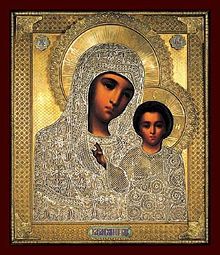
The apostle Luke was Greek and a friend of the apostle Paul. He was a doctor. Luke came to know about Jesus from the disciples. Luke writes about the birth and the childhood of Jesus and he says "Mary kept all these things in her heart and thought about them."[39]
Luke was not a Jew and he writes in a way that is easy for other people who are not Jews to understand. He explains Jewish customs and laws. He wrote a second book called the Acts of the Apostles which tells what the disciples did after Jesus had left them.
About John
It is believed by scholars of the Bible that John was a disciple of Jesus and was probably the youngest of the twelve men who were Jesus' main followers.[39] He lived to be an old man and, because of his teaching about Jesus, he was sent to a small island, called Patmos. John writes with one particular idea in mind. He wants to prove to the reader that Jesus is God's way of saving humans from the terrible problem of sin or evil. John starts by telling the reader that Jesus was and is God. John says that Jesus is God's Living Communication (or Living Word). Every part of John's Gospel is written to show that Jesus came from God, taught the Message of God and is the way for people to understand God's Love.[30]
Teaching with stories
The Gospels tell many of the stories that Jesus told when he was teaching people about the way that God loved them and the way they should live. These are called parables. They include the following:
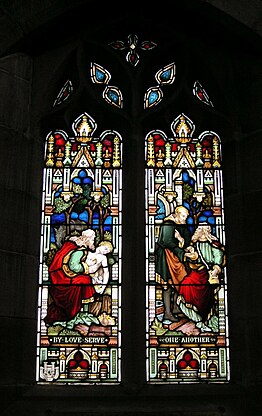
The Good Samaritan
In this story from chapter 10 of Luke's Gospel, Jesus shows what it means to be a good neighbour. Near the Jews lived the people called Samaritans. They did not agree with each other about religious teaching, and were considered enemies. One day, a Jewish man was walking, when some robbers beat him up, robbed him, and left him naked and almost dead, by the road. A Jewish priest came along and saw him. He thought, "If I touch that naked bleeding man, I will be unclean and I will not be able to go to the Temple!" So he pretended that he had not seen him. Another Jew, a Holy Man, came along and acted in the same way. At last a Samaritan came along with a donkey. When he saw the wounded man he stopped. He washed his wounds with wine and olive oil. Then he put him on his donkey and took him to the nearest inn. He paid the innkeeper and said "Keep him until he is well, and whatever is owing, I will pay when I come back this way." Jesus said to the people who were listening "Which one of these people acted like a good neighbour?" They said "He that stopped and helped." Jesus said "You go and act the same way."
The Prodigal Son
In this story from chapter 15 of Luke's Gospel, Jesus tells how a rich man had two sons. They would both get a share of his money, when he died. The younger son said, "Father, give me my money now, so I can go and enjoy myself, while I'm young." He took the money to the city, and spent it all on parties with his friends and other sinful things. Soon he had none left to feed himself and was ashamed. He got a job caring for pigs, a unholy meat to eat, just keep himself from starving. He said to himself, "I'll go home to my father and I will say, 'Father, I have sinned! Please let me be a servant in your house!'" When his father saw him coming, he ran along the road to put his arms around his son. The father said, "Bring the finest clothes! Kill the fattest calf to make a feast!" When the elder brother heard all this, he was angry and said, "I'm a good son to you, but you never even gave me one little goat to have a party with my friends!" The father said, "You have always been with me. I love you greatly, and all I have is yours, but my son who was lost is now found! My son who seemed to be dead is alive! Be happy with me!" Jesus said that this is the way God loves and forgives his people, when they ask for forgiveness.
Related pages
Notes
- ↑ Tacitus tells about the death of Jesus in his Annales: Perseus-Project: Annales 15,44 In the passage, Tacitus talks about the burning of Rome, which Nero attributed to the Christians (or Chrestians): Christus, from whom the name had its origin, suffered the extreme penalty during the reign of Tiberius at the hands of one of our procurators, Pontius Pilatus, and a most mischievous superstition, thus checked for the moment, again broke out not only in Judaea, the first source of the evil, but even in Rome, where all things hideous and shameful from every part of the world find their centre and become popular.
- ↑ Easter is not held on the same date every year, because Jesus' death is always remembered on a Friday called "Good Friday". Easter is celebrated the first Sunday following the first full moon after the Spring Equinox. This means it can be celebrated in March or April. Western churches, like the Roman Catholic Church, use the Gregorian calendar and Eastern churches, like the Eastern Orthodox Church, use the Julian calendar. Because of this, the date of Easter celebrations is different for these two types of churches even though the way they calculate the date is the same.
- ↑ Paraphrased
- ↑ This is one of many songs or "psalms" are believed to have been written by David, a shepherd boy who became the King of Israel and was a great musician. Matthew's Gospel shows that Jesus' father was the direct descendant of King David.
References
- ↑ "World's top ten most significant people EVER (according to Wikipedia)". Mail Online. 10 December 2013.
- ↑ "Top Ten Lists at TheTopTens.com". www.thetoptens.com. Archived from the original on 2019-01-08. Retrieved 2019-02-14.
- ↑ "Jesus Christ — the most famous Person in history - Voice in the Wilderness Ministries".
- ↑ "Jesus is the most famous person in history, followed by Napoleon and then Muhammad. | the History Vault". Archived from the original on 2016-03-17. Retrieved 2017-11-17.
- ↑
- ↑ Cohen (1987). pp. 78, 93, 105, 108.
- ↑ Crossan. pp. xi—xiii.
- ↑ Grant, Michael. pp. 34–35, 78, 166, 200.
- ↑ Meier, John P. (1993). 1:68, 146, 199, 278, 386, 2:726. Sanders. pp. 12–13.
- ↑ "Bible Gateway passage: Mark 1:15 - New International Version". Bible Gateway. Retrieved 2018-10-01.
- ↑ Sanders 1993, p. 12.
- ↑ Levine 2006, p. 4.
- ↑
- ↑
- ↑
- ↑ "When Jesus found unbelief on their part He said: Who will be My helpers to(the work of) Allah? said the disciples;"We are Allah's helpers We believe in Allah and do thou bear witness that we are Muslims". Surah 3 al Imran, verse 52
- ↑
- ↑ Rishi Das, Shaunaka (March 24, 2009). "Jesus in Hinduism". BBC.
- ↑ Beverley, James A. (June 11, 2011). "Hollywood's Idol". Christianity Today.
- ↑
- ↑ Matthew 1:18-23
- ↑ Luke 1:26-38
- ↑ Luke 1:41-45
- ↑ Luke 2:1-5
- ↑ Luke 2:7-20
- ↑ Matthew 2:1-11
- ↑ Luke 2:21
- ↑
- ↑ Mark 11:17,18 and Mark 12:40
- ↑ 30.0 30.1 30.2 "SALVATION: WHAT DID THE GOSPEL WRITERS AND PAUL SAY?". Archived from the original on 2008-10-15. Retrieved 2008-04-25.
- ↑ "Comparison Chart: Religious Views of Jesus". religionfacts.com. 2014. Retrieved 12 July 2014.
- ↑ Fitzgerald, Michael (2014). "Christ and the other religions". Commission for Interreligious Dialogue. Retrieved 12 July 2014.
- ↑ "Religious Tolerance- Salvation". Archived from the original on 2008-11-20. Retrieved 2008-04-25.
- ↑ "Quran translation Comparison | Al-Quran Surah 4. An-Nisaa, Ayah 157 | Alim". www.alim.org. Archived from the original on 2020-10-26. Retrieved 2020-12-14.
- ↑ Mark D. Roberts, Are the New Testament Gospels Reliable?
- ↑ Augustine, De Adulterinis Conjugiis 2:6–7, Cited in Wieland Willker, A Textual Commentary on the Greek Gospels, Vol. 4b, p. 10.
- ↑ "Manuscript History and John 8:1-8:11". Archived from the original on 2022-11-18. Retrieved 2022-11-18.
- ↑ "Text and Manuscripts of the New Testament - Encyclopedia of the Bible - Bible Gateway".
- ↑ 39.0 39.1 39.2 39.3 39.4 James Patrick Holding, The New Testament- Gospel Dates, Gospel Authors, Gospel Freedoms,[1]
Further reading
- Crossan, John Dominic.
- Levine, Amy-Jill (2006). "Introduction". In Levine, Amy-Jill; Allison, Dale C.; Crossan, John D. (eds.). The Historical Jesus in Context. Princeton Univ Press. ISBN 978-0-691-00992-6.
Other websites
Template:PAGEBANNER:Spas vsederzhitel sinay.jpg
{{#seo:
| type = article | description = Jewish teacher and reformer of religion who is the central figure of Christianity. | author = Script error: No such module "popular". | keywords = | image = https://upload.wikimedia.org/wikipedia/commons/thumb/4/4a/Spas_vsederzhitel_sinay.jpg/960px-Spas_vsederzhitel_sinay.jpg
}}
